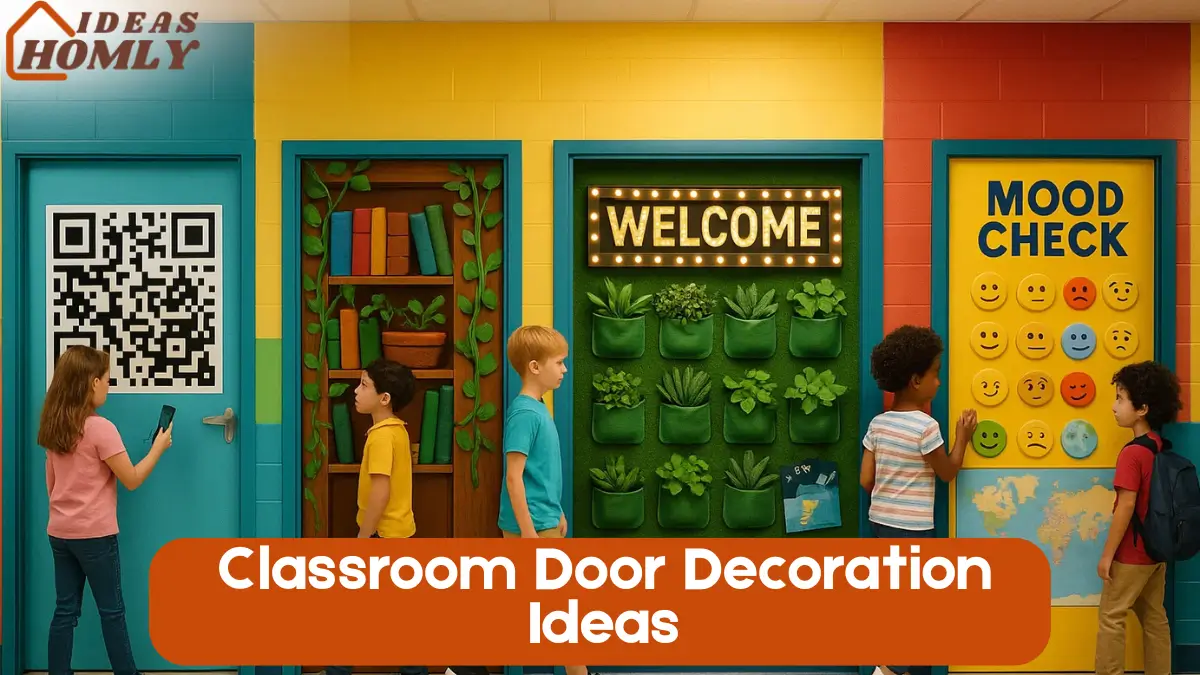As someone who has always been passionate about thoughtful and creative decor, whether it’s in the home or classroom, I truly believe that a well-decorated classroom door can do more than just look good. It sets the tone the moment students walk in.
Over the years, I’ve noticed that students feel more welcomed, more engaged, and even more curious when classroom doors speak their language, colorful, fun, and interactive.
Classroom aesthetics aren’t just for show. They’re part of the learning environment. From reducing anxiety to sparking interest in a subject, even small design details on classroom doors can make a big difference in students’ day-to-day experience.
That’s why I’ve put together these 6 creative and interactive classroom door decoration ideas that combine style with purpose. These aren’t just decorative, they’re conversation starters, mood boosters, and learning tools in disguise.
1. Interactive AR QR-Code Portal
Engagement starts before the lesson even begins. That’s the idea behind using QR codes on classroom doors.
I tried this last year with a science theme, and it was a hit. Each week, I placed a new QR code on the door that students could scan before entering.
It is linked to fun facts, mini video clips, or even weekly challenges. Students actually looked forward to seeing what the door had for them next.
How It Works?
- Design a thematic poster for your door.
- Add printed QR codes that lead to curated content, Google Slides, YouTube videos, or classroom blogs.
- You can even personalize codes for birthdays, weekly star students, or book recommendations.
You can buy Label or QR Printer or a more popular Brother P-touch PTD610BT Label Maker for your classroom.
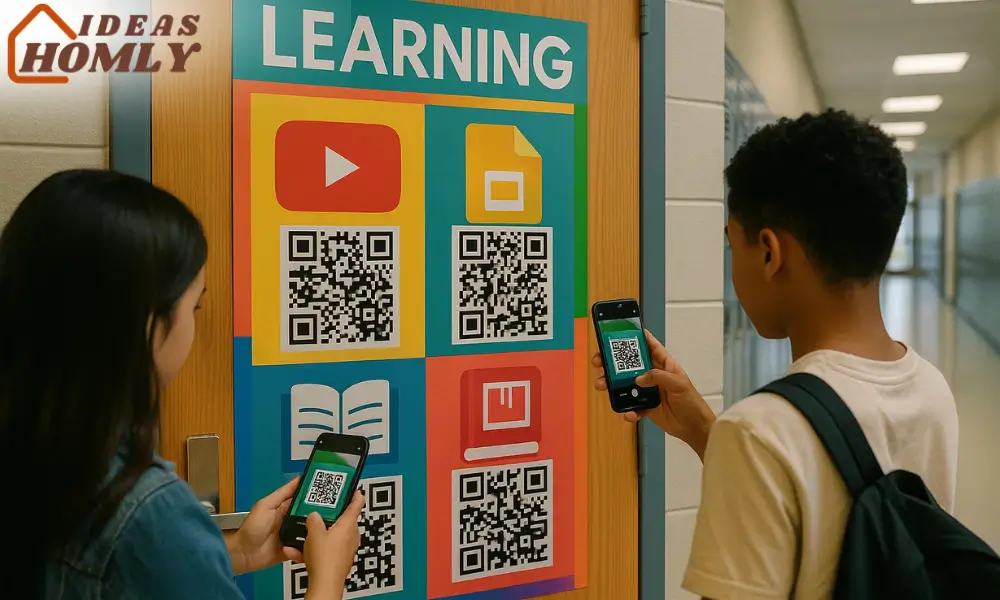

Back to School Classroom Door Decorations
Why It Works:
- Keeps content fresh and constantly engaging
- Encourages tech use in a controlled way
- Appeals to digital-native learners
This setup works best with subjects like history, science, or literature, where supplemental digital content adds value. Plus, it’s an easy way to bring the classroom to life even before the first bell rings.
You’ll also love this article: DIY Graduation Banner Ideas For Party Decor
2. 3-D Book-Nook Entrance
One of my favorite classroom door makeovers was inspired by the idea of stepping into a storybook. I turned the door into a 3-D book nook, complete with paper vines, open book cut-outs, and stacked faux books around the frame.
It took a few evenings and a lot of cardboard, but the reactions from students were priceless. They felt like they were entering a secret reading world every time they came in.
Design Elements to Include:
- A door-sized backdrop painted or printed like a bookshelf
- Pop-out elements like open books, characters, or 3D windows
- Paper or foam vines climbing the sides for an enchanted touch
This door decor idea is ideal for reading corners, library classrooms, or even language arts rooms. It creates an immersive feeling, something beyond plain posters or borders.
You can also try these Artificial ivy garlands or buy this affordable Fire HD 10 Kids Pro Tablet for your classroom.
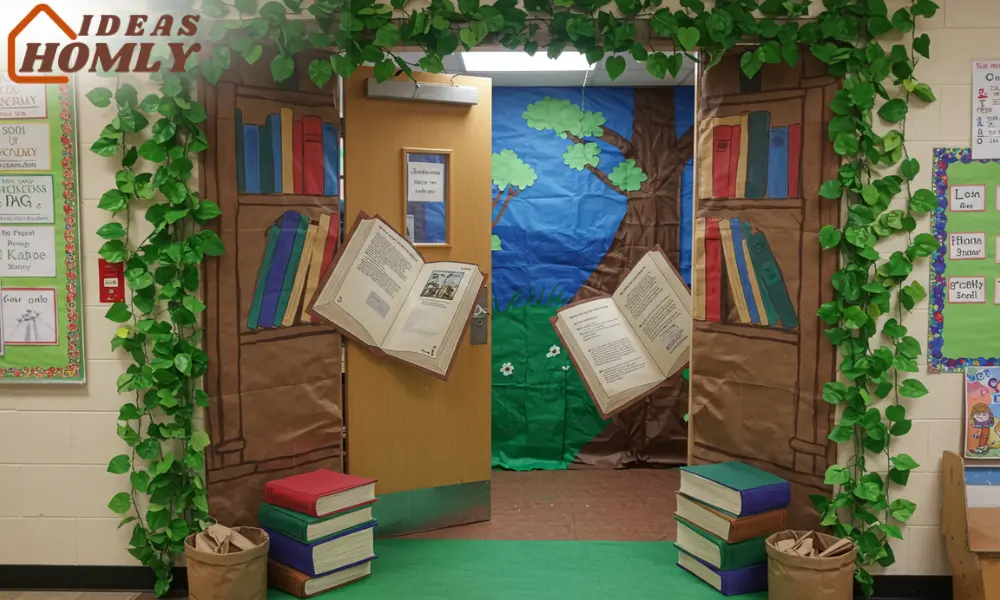
Variations:
- Mystery-themed for older students
- Fairytale forest for younger grades
- Genre-specific setups: sci-fi, adventure, or poetry
A 3-D book-themed door doesn’t just decorate, it invites. It subtly encourages reading and sparks imagination every single day.
3. Living Pocket Garden Door
This one adds a real natural element to the classroom. A few years ago, I created a “living” pocket garden door by attaching vertical rows of fabric pockets to the door, each pocket holding a low-maintenance plant or faux greenery for a cleaner alternative.
Some teachers use felt pockets with students’ names. I went for a garden-style layout, and I can’t count how many times students paused to check the plants.
Features to Consider:
- Use plastic sleeves, felt shoe organizers, or sewn canvas as your base
- Label each pocket with a student’s name, plant type, or motivational word
- Mix in artificial succulents if maintenance is a concern
Besides the beauty, it brings calmness into the space. Some students told me they felt less anxious walking into a classroom that had greenery, even if it was fake. And let’s be honest, we could all use a little more calm in our day.
You can use this over the door vertical shoe organizer for hanging living plants on your classroom door and use these Mini Artificial Succulent Pack as fake plants.

Benefits:
- Encourages responsibility (students can take care of the plants)
- Adds texture and depth to the decor
- Great for nature-themed or science classrooms
If you’re not allowed to mount directly on the door, you can hang the garden from a tension rod or command hooks on the sides. It’s versatile, soothing, and always a conversation starter.
Check this out: Graduation Gift Ideas for Beloved Friends
4. Solar-LED Welcome Marquee
One of the most eye-catching door setups I’ve ever done involved a solar-powered LED sign. I turned the classroom door into a mini marquee that lit up with a welcoming message.
At first, I was skeptical. Would the lights even work inside? But with a small solar strip near the window and a rechargeable battery setup, it worked beautifully. The warm, glowing message greeted students with “Let’s Shine Bright Today!” every morning.
What You’ll Need:
- A lightweight LED strip or marquee letters
- Solar or rechargeable battery pack (hidden in a corner)
- Foam board for the sign structure
- Printed welcome messages that can be swapped weekly
This kind of decor works best near windows for the solar setup, or you can simply recharge the lights weekly if sunlight is limited.
You can use this LED Letter Board with lights and this Felt Letter Board for your classroom door decoration.
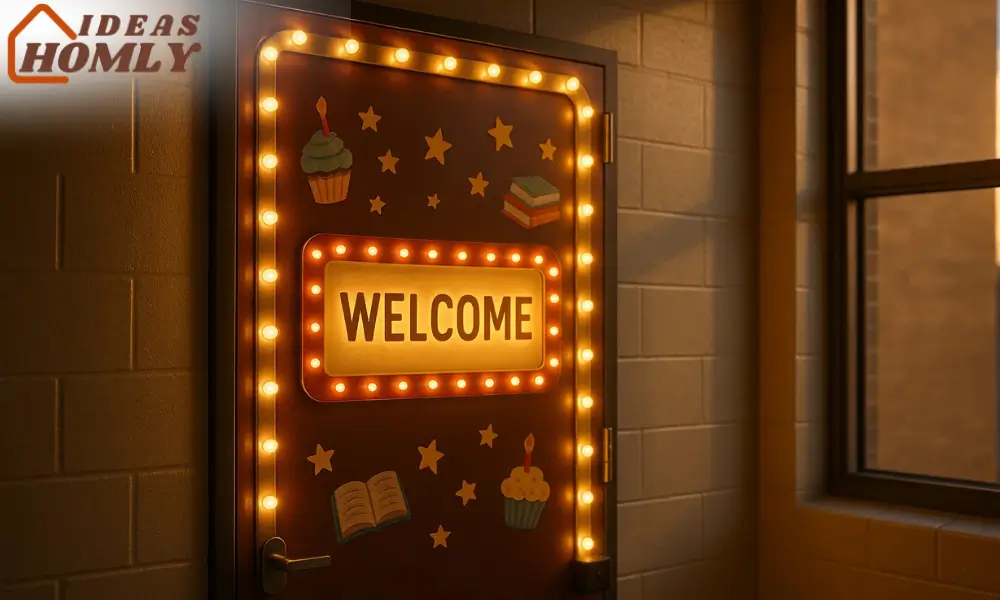
Why Students Love It:
- It feels like a performance is about to start
- Makes the room feel special and modern
- You can easily change messages to celebrate birthdays, tests, or holidays
It might sound high-effort, but honestly, it doesn’t take much time once set up. And it adds a huge “wow” factor with very little maintenance.
5. Magnetic Emoji Mood Check-In
This is one of the most interactive and emotionally supportive door ideas I’ve used and it’s something I now consider essential for any classroom.
The concept is simple. I added a large laminated board to the door with emoji magnets. Each morning, students place their name magnet next to the emoji that reflects how they’re feeling. Happy, tired, worried, excited, it’s all right there.
Why It Works:
- Encourages emotional awareness in a non-verbal way
- Gives me a chance to check in quietly with students who need support
- Fosters a classroom culture of care and empathy
I created a pocket chart next to the board where students return their magnets at the end of the day. This also helps build routine and responsibility.
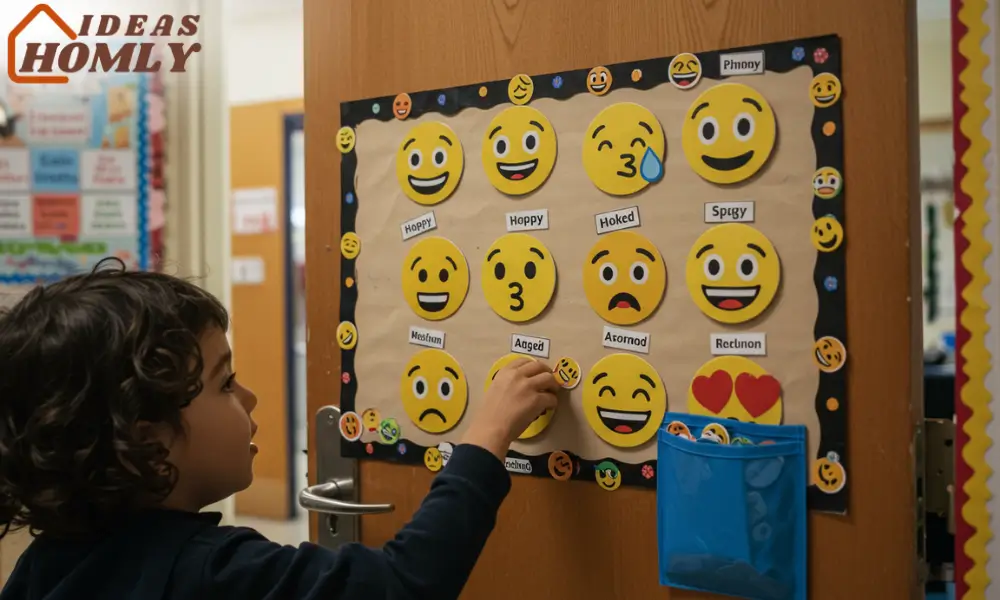
Materials I Used:
- Adhesive magnet tape or printable magnetic sheets
- Emojis printed and laminated
- Name magnets for each student
You can even color-code or add seasonal emojis. Around Halloween, I switched them to themed faces students noticed and appreciated the detail. This idea doesn’t just decorate, it supports mental well-being in a subtle but powerful way.
6. Passport-Window Adventure
If your students love adventure stories or social studies, this passport-themed door will be a hit. I transformed the top panel of my door into a faux airplane window.
Below it, I added mini “passports” for each student and a large map showing our “learning destinations” throughout the year.
Each time we finished a major unit like Ancient Egypt or World Continents, I added a stamp to their passport.
What Makes It Fun:
- Turns learning units into “travel experiences”
- Builds anticipation for upcoming topics
- Encourages classroom unity and progress tracking
You can find free printable passports online or create your own. I laminated mine so they’d last all year, and Velcro strips made them easy to remove and update.
This setup creates a sense of journey and exploration that ties into lesson plans. Students begin to see themselves not just as learners, but as global explorers, and that changes how they show up.
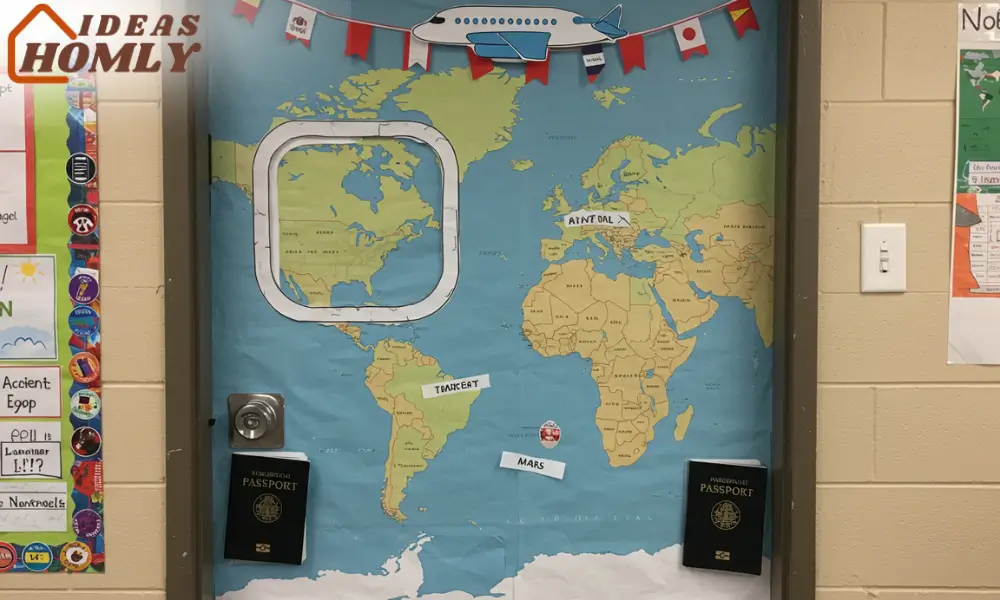
Tips for Long-Lasting Classroom Door Decor
Over the years, I’ve learned a few smart tricks that help keep even the most detailed door decorations looking fresh and intact all year long.
1. Use Laminated Elements
Laminating your paper or cardboard pieces keeps them resistant to wear and tear. It also makes them easier to clean. You can use this laminator with laminating sheets.
2. Reinforce with Velcro or Magnetic Tape
Instead of using just staples or glue, try Velcro dots or magnetic strips. They let you swap pieces out without damage.
3. Go Modular
Design in sections. That way, if one part gets damaged, you can replace just that section rather than redoing the whole door.
4. Avoid Heavy Materials
Stick with lightweight foam, felt, or cardboard. Heavier items tend to fall off or damage the door.
5. Prep for Seasonal Changes
I keep labeled folders of decor elements by season or theme. It’s easy to update and rotate without starting from scratch every time.
Conclusion
After years of decorating classrooms and crafting creative spaces, I’ve learned one key thing: a classroom door is more than just a physical entry. It’s the first invitation into a space where learning, connection, and imagination happen daily.
Whether it’s through tech-driven tools like QR codes, calming touches like a living pocket garden, or emotion-focused ideas like mood check-ins, every door can tell a story. A story that students become part of the moment they walk in.
You don’t have to be an artist or invest a lot of money. What truly matters is intention, creating a welcoming, engaging environment that supports curiosity, safety, and fun.
So, pick one idea, or mix a few. Customize it to your grade level, your subject, and your teaching style. Over time, you’ll see how even the smallest detail, like a laminated emoji or a faux window, can spark big emotions and lasting memories.
FAQs
It depends on your theme and how interactive your setup is. Some teachers change their doors every season, while others keep the same core structure and update small parts monthly. Personally, I find quarterly refreshes strike a perfect balance; it keeps things fresh without being overwhelming.
No problem at all! Even half-doors or side panels work well. You can use foam boards or poster sheets to create removable door toppers or side decorations. I’ve even created “mini doors” on bulletin boards to mimic the idea when space was tight.
Absolutely. Many of the ideas I shared can be created using materials you already have: cardboard, old folders, laminated printables, or even recycled packaging. I often print decorations in black and white and have students color them in as part of a classroom activity.
Younger students love interactive, colorful, and tactile elements. Themes like storybooks, nature, emotions, and travel work really well. I always include soft textures, fun characters, and names so students feel personally connected to the door design.
Great question, and one I’ve learned the hard way. Always check with your school administration before covering an entire door. Avoid blocking windows, ensure exit signs remain visible, and use fire-safe materials. I usually create modular panels that can be quickly removed during drills or inspections.

